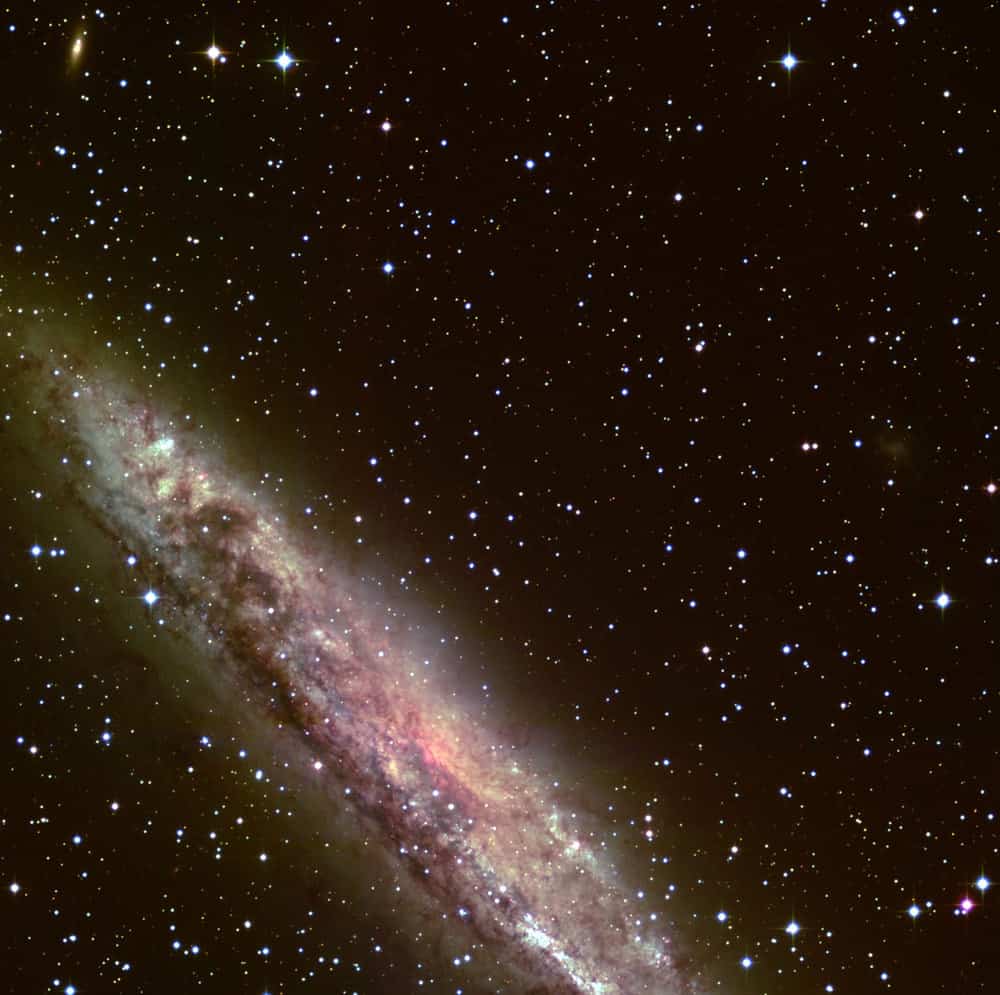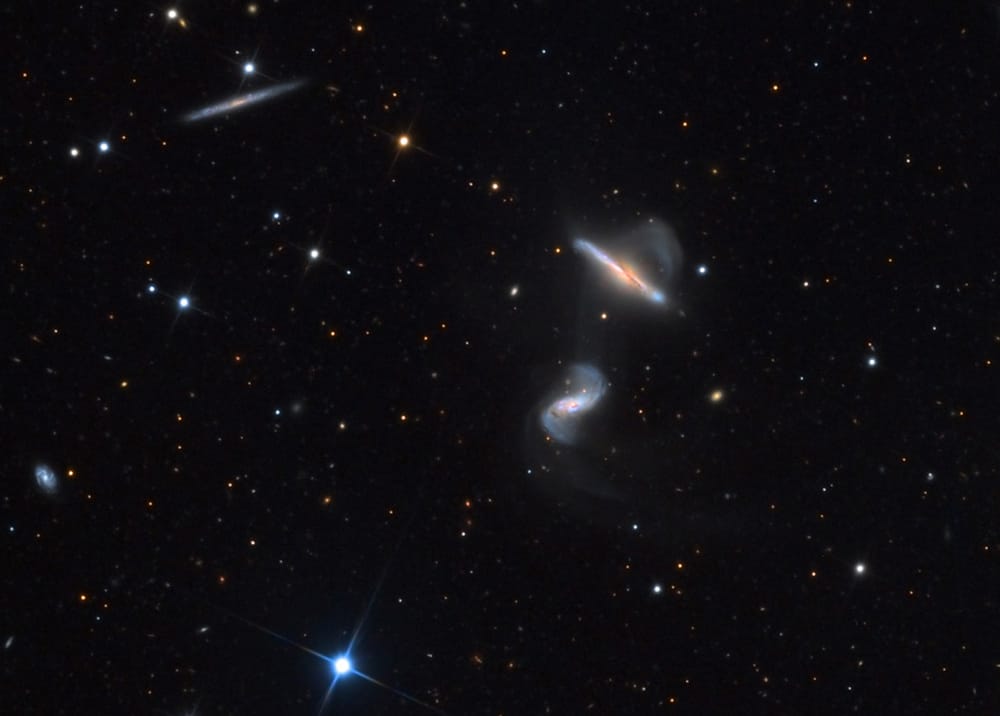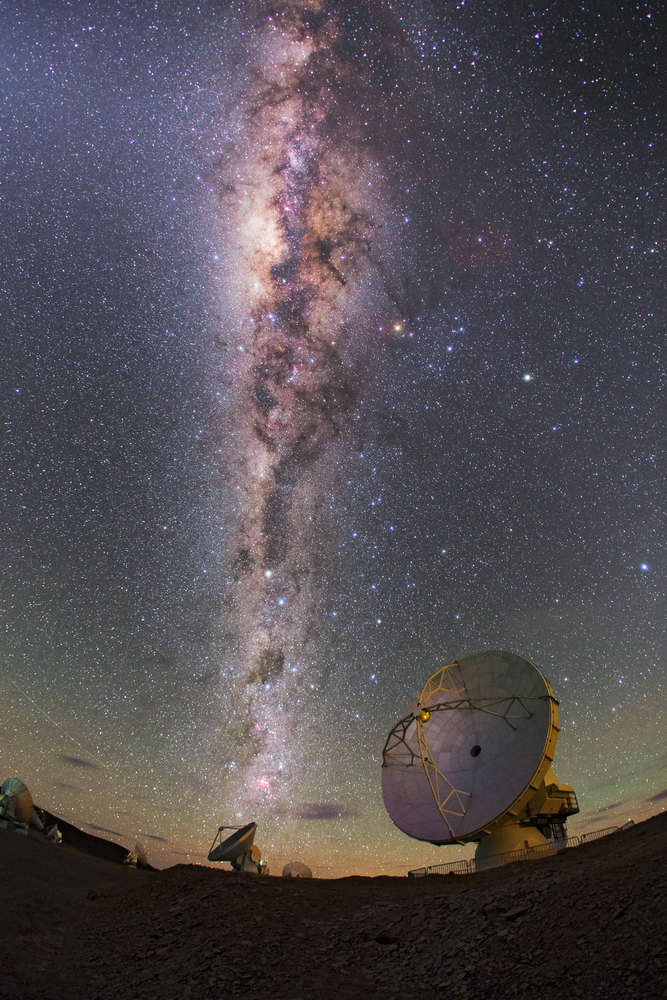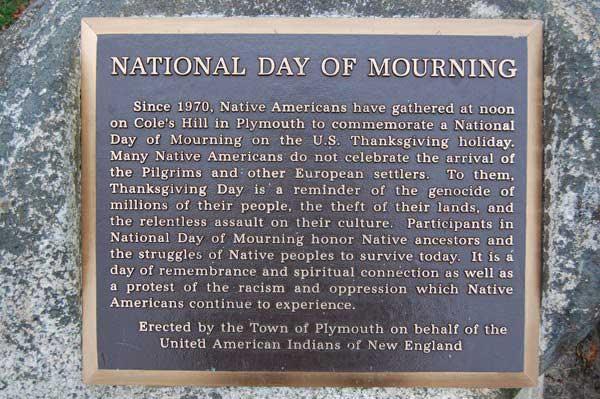Blog
Ike Isaacs (December 1, 1919, Rangoon, Burma – January 11, 1996, Sydney, Australia) was a jazz guitarist from Rangoon, Burma, best known for his work with violinist Stéphane Grappelli.
Isaacs was self taught on guitar. He started playing professionally in college while pursuing a degree in chemistry. In 1946 he moved to England, where he became a member of the BBC Show Band. During the 1960s and ’70s, he was a member of the Hot Club of London, led by guitarist Diz Disley, which often collaborated with Stéphane Grappelli. He was a member of the band Velvet with Digby Fairweather, Len Skeat, and Denny Wright. In the 1980s, he moved to Australia and taught at the Sydney School of Guitar.
more...This image is an enlargement at full resolution of a smaller region (about 1/7 by area) of a sky field around the spiral galaxy NGC 4945 . It is assembled from five 15-minute R(ed)-narrowband (shown in red), four 5-minute B(lue)-band (shown in green), and five 1000-second U(ltraviolet)-band (shown in blue) exposures, obtained in January 1999 during the Science Verification phase with the Wide-Field-Imager (WFI) at the MPG/ESO 2.2-m telescope at La Silla. At the recession velocity of NGC 4945, the red filter, centred at 665 nm with an FWHM (full width at half maximum) of only 1.2 nm, does not include the H-alpha emission line of interstellar hydrogen in this galaxy. The original resolution of about 1 arcsec corresponds to roughly 62 light-years at the distance of NGC 4945 (13 million light-years). In addition to NGC 4945 itself, some much more distant galaxies can be recognized as faint, slightly red light patches in the field. The vast majority of the point-like sources are stars in the Milky Way. However, a fair number of those near NGC 4945 are globular clusters belonging to this galaxy. Each frame records 8184 x 8196 = 67,076,064 pixels, and thus the total number of data points (pixels) of the 14 CCD frames used to make this photo is almost 10 9. Their collective information content corresponds to more than 70 x 10 9 photons (not counting those from the Earth’s upper atmosphere that were recorded simultaneously). It covers 2997 x 2998 pixels and measures about 12 x 12 arcmin 2 in the sky. Note the many background galaxies in the field.

Johnny Shuggie Otis (born Johnny Alexander Veliotes, Jr.; November 30, 1953) is an American singer-songwriter, recording artist, and multi-instrumentalist.
Otis’s composition “Strawberry Letter 23” (as recorded by The Brothers Johnson) topped the Billboard R&B chart and reached #5 of the Billboard Hot 100 chart in 1977. He also achieved commercial success with his 1974 single “Inspiration Information” (from the album of the same title), reaching #56 on the R&B chart.
Born in Los Angeles, California, Otis is the son of rhythm and blues pioneer, musician, bandleader, and impresario Johnny Otis, who was of Greekdescent, and his wife Phyllis Walker, who was of African American and Filipino descent. The name “Shuggie” (short for “sugar,” according to his mother) was coined by Phyllis when he was a newborn. Otis began playing guitar when he was two years old and performing professionally with his father’s band at the age of eleven, often disguising himself with dark glasses and a false mustache so that he could play with his father’s band in after-hours nightclubs.
more...Jack Sheldon (born November 30, 1931) is an American bebop and West Coast jazz trumpeter, singer, and actor. He is a trumpet player and was the music director on The Merv Griffin Show, as well as the voice heard on several episodes of the educational music television series Schoolhouse Rock! Sheldon was born in Jacksonville, Florida, United States. He originally became known through his participation in the West Coast jazz movement of the 1950s, performing and recording with such figures as Art Pepper, Gerry Mulligan, and Curtis Counce. Sheldon played the trumpet, sang, and performed on The Merv Griffin Show. He was Griffin’s sidekick for many years. Prior to joining Griffin’s show, he served as bandleader for the short-lived The Las Vegas Show.
https://www.youtube.com/watch?v=m4ZKqwvuRLs
Walter Brown “Brownie” McGhee (November 30, 1915 – February 16, 1996) was an African-American folk music and Piedmont blues singer and guitarist, best known for his collaboration with the harmonica player Sonny Terry. McGhee was born in Knoxville, Tennessee, and grew up in Kingsport, Tennessee. At about the age of four he contracted polio, which incapacitated his right leg. His brother Granville “Sticks”(or “Stick”) McGhee, who also later became a musician and composed the famous song “Drinkin’ Wine Spo-Dee-o-Dee,” was nicknamed for pushing young Brownie around in a cart. Their father, George McGhee, was a factory worker, known around University Avenue for playing guitar and singing. Brownie’s uncle made him a guitar from a tin marshmallow box and a piece of board.
McGhee spent much of his youth immersed in music, singing with a local harmony group, the Golden Voices Gospel Quartet, and teaching himself to play guitar. He also played the five-string banjo and ukulele and studied piano. Surgery funded by the March of Dimes enabled McGhee to walk.
At age 22, McGhee became a traveling musician, working in the Rabbit Foot Minstrels and befriending Blind Boy Fuller, whose guitar playing influenced him greatly. After Fuller’s death in 1941, J. B. Long of Columbia Records promoted McGhee as “Blind Boy Fuller No. 2.” By that time, McGhee was recording for Columbia’s subsidiary Okeh Records in Chicago, but his real success came after he moved to New York in 1942, when he teamed up with Sonny Terry, whom he had known since 1939, when Terry was Fuller’s harmonica player. The pairing was an overnight success. They recorded and toured together until around 1980. As a duo, Terry and McGhee did most of their work from 1958 until 1980, spending 11 months of each year touring and recording dozens of albums.
more...Robert Lee McCollum (November 30, 1909 – November 5, 1967) was an American blues musician who played and recorded under the pseudonyms Robert Lee McCoy and Robert Nighthawk. He was the father of the blues musician Sam Carr.
McCollum was born in Helena, Arkansas. He left home at an early age and became a busking musician. After a period traveling through southern Mississippi, he settled for a time in Memphis, Tennessee, where he played with local orchestras and musicians, such as the Memphis Jug Band. A particular influence during this period was Houston Stackhouse, from whom he learned to play slide guitar and with whom he performed on the radio in Jackson, Mississippi.
After further travels through Mississippi, he found it advisable to take his mother’s name and, as Robert Lee McCoy, moved to St. Louis, Missouri, in the mid-1930s. Local musicians with whom he played included Henry Townsend, Big Joe Williams, and Sonny Boy Williamson. This led to two recording dates in 1937, the four musicians recording together at the Victor Records studio in Aurora, Illinois, as well as recordings under his own name, including “Prowling Night-Hawk” (recorded 5 May 1937), from which he was to take his later pseudonym. These sessions led to Chicago blues careers for the other musicians, though not for McCoy, who continued his rambling life, playing and recording (for Victor/Bluebird Records and Decca Records) solo and with various other musicians, under various names. Kansas City Red was his drummer from the early 1940s to around 1946. He recorded Kansas City Red’s song “The Moon Is Rising”. McCoy became a familiar voice on local radio stations including WROX. A teenaged Ike Turner joined his band as a roadie in Clarksdale, Mississippi. Then Robert Lee McCoy disappeared. Within a few years, he resurfaced as the electric slide guitarist Robert Nighthawk and began recording for Aristocrat and Chess Records, the latter of which was also Muddy Waters‘s label. In 1949 and 1950, the two men’s styles were close enough that they were in competition for promotional activity. Waters was the more marketable commodity, being more reliable and a more confident stage communicator, and thus received the attention. Nighthawk continued to perform and record, taking up with United Records and States Records 1951 and 1952, but did not achieve great commercial success.
more...
https://www.youtube.com/watch?v=cqiKEWveYCU
more...While it’s common for galaxies to coexist peacefully in the same cosmic neighborhood, these two galaxies are a bit too close for comfort. The galaxies NGC 6286 (right) and NGC 6285 (left), collectively known as Arp 293, are tugging at each other with their mutually strong gravitational attraction, dragging wisps of gas and dust out from the galaxies and into interstellar space. This causes the galaxies to appear “smudged” and blurred from our perspective on Earth. The Hubble Space Telescope captured this image of the galactic pair, which are located more than over 250 million light-years from Earth in the constellation Draco. NGC 6285 is an interacting spiral galaxy located in the constellation Draco. It is designated as S0-a in the galaxy morphological classification schemeand was discovered by the American astronomer Lewis A. Swift in 1886. NGC 6285 is located at about 262 million light years away from earth. NGC 6285 and NGC 6286 form a pair of interacting galaxies, with tidal distortions, categorized as Arp 293 in the Arp Atlas of Peculiar Galaxies.

more...
Billy Hart (born November 29, 1940) is an American jazz drummer and educator. Hart was born in Washington, D.C., where early on in his career he performed with soul artists such as Otis Redding and Sam and Dave, and then later with Buck Hill and Shirley Horn, and was a sideman with the Montgomery Brothers (1961), Jimmy Smith (1964–1966), and Wes Montgomery(1966–68). Following Montgomery’s death in 1968, Hart moved to New York, where he recorded with McCoy Tyner, Wayne Shorter, and Joe Zawinul, and played with Eddie Harris, Pharoah Sanders, and Marian McPartland.
Hart was a member of Herbie Hancock‘s sextet (1969–73), and played with McCoy Tyner (1973–74), Stan Getz (1974–77), and Quest (1980s), in addition to extensive freelance playing (including recording with Miles Davis on 1972’s On the Corner).
Since the early 1990s, Hart has been associated with Oberlin Conservatory of Music, and is also adjunct faculty at the New England Conservatory of Music and Western Michigan University. He also conducts private lessons through the New School and New York University. The drummer often contributes to the Stokes Forest Music Camp and the Dworp Summer Jazz Clinic in Belgium.
He has led a group with Mark Turner, Ethan Iverson, and Ben Street, is featured in a trio led by pianist Jean-Michel Pilc, another led by guitarist Assaf Kehati, and has performed in a band known as the Cookers, with Eddie Henderson, David Weiss, Craig Handy, George Cables and Cecil McBee, all who have toured extensively and recorded two CDs. Hart resides in Montclair, New Jersey.
https://www.youtube.com/watch?v=W3lDcLUnpJI
more...John Mayall, OBE (born 29 November 1933) is an English blues singer, guitarist, organist and songwriter, whose musical career spans over sixty years. In the 1960s, he was the founder of John Mayall & the Bluesbreakers, a band which has counted among its members some of the most famous blues and blues rock musicians. Born in Macclesfield, Cheshire in 1933, Mayall was the son of Murray Mayall, a guitarist and jazz music enthusiast. From an early age, John was drawn to the sounds of American blues players such as Lead Belly, Albert Ammons, Pinetop Smith and Eddie Lang, and taught himself to play the piano, guitars, and harmonica.
In 1956, with college fellow Peter Ward, Mayall had founded the Powerhouse Four which consisted of both men and other local musicians with whom they played at local dances. In 1962 Mayall became a member of the Blues Syndicate. The band was formed by trumpeter John Rowlands and alto saxophonist Jack Massarik, who had seen the Alexis Korner band at a Manchester club and wanted to try a similar blend of jazz and blues. It also included rhythm guitarist Ray Cummings and drummer Hughie Flint, whom Mayall already knew. In 1962 John and his band were frequent and popular artists at all night R&B sessions at the ‘Twisted Wheel’ cellar club in central Manchester. Alexis Korner persuaded Mayall to opt for a full-time musical career and move to London, where Korner introduced him to many other musicians and helped them to find gigs. In late 1963, with his band, which was now called the Bluesbreakers, Mayall started playing at the Marquee Club. The line-up was Mayall, Ward, John McVie on bass and guitarist Bernie Watson, formerly of Cyril Davies and the R&B All-Stars. The next spring Mayall obtained his first recording date with producer Ian Samwell. The band, with Martin Hart at the drums, recorded two tracks : “Crawling Up a Hill” as well as “Mr. James.” Shortly after, Hughie Flint replaced Hart and Roger Dean took the guitar from Bernie Watson. This line-up backed John Lee Hooker on his British tour in 1964.
Mayall was offered a recording contract by Decca and, on 7 December 1964, a live performance of the band was recorded at the Klooks Kleek. A later studio-recorded single, “Crocodile Walk”, was released along with the album, but both failed to achieve any success and the contract was terminated.
In April 1965 former Yardbirds guitarist Eric Clapton replaced Roger Dean and John Mayall’s career entered a decisive phase.
William Thomas Strayhorn (November 29, 1915 – May 31, 1967) was an American jazz composer, pianist, lyricist, and arranger, best remembered for his long-time collaboration with bandleader and composer Duke Ellington that lasted nearly three decades. His compositions include “Take the ‘A’ Train“, “Chelsea Bridge“, “A Flower Is a Lovesome Thing“, and “Lush Life“.
Strayhorn was born in Dayton, Ohio. His family soon moved to the Homewood section of Pittsburgh, Pennsylvania. However, his mother’s family was from Hillsborough, North Carolina, and she sent him there to protect him from his father’s drunken sprees. Strayhorn spent many months of his childhood at his grandparents’ house in Hillsborough. In an interview, Strayhorn said that his grandmother was his primary influence during the first ten years of his life. He first became interested in music while living with her, playing hymns on her piano, and playing records on her Victrola record player.
more...
The basic structure of bulerías
Bulerías, like other flamenco forms, has its own language. When we dance we are in conversation with the singer, the guitarist, and the palmeros. The structure offers a formula for clear communication, and it looks like this:
-
Salida
-
Marcaje(s)
-
Paso de bulerías (or a more upbeat marcaje)
-
Llamada
-
Patá (Patada)
-
(Another Marcaje or Paso de Bulerías)
-
Llamada
-
Final
The Milky Way glitters brightly over ALMA antennas, in this image taken by the ESO Ultra High Definition Expedition team as they capture the site in 4K quality.
In the Chajnantor Plateau in the Atacama Desert, one of the highest and driest places on Earth, a gentle “rain” is falling. It is light from space, in millimetric and submillimetric wavelengths, a natural, scarce and precious resource. It is well-known that these waves are full of information about our cosmic origins, that is why people thirsty for this knowledge have gathered here to collect, channel and analyze it.
This is what gives rise to the Atacama Large Millimeter/submillimeter Array (ALMA), currently the largest radio telescope in the world. This achievement is the result of an international association between Europe (ESO), North America (NRAO) and East Asia (NAOJ), in collaboration with the Republic of Chile, to build the observatory of the “Dark Universe”.

Randall Stuart Newman (born November 28, 1943) is an American singer-songwriter, arranger, composer and pianist who is known for his distinctive voice, mordant (and often satirical) pop songs and film scores.
Since the 1980s, Newman has worked mostly as a film composer. His film scores include Ragtime, Awakenings, The Natural, Leatherheads, Pleasantville, Meet the Parents, Cold Turkey and Seabiscuit. He has scored nine Disney–Pixar animated films: Toy Story; A Bug’s Life; Toy Story 2; Monsters, Inc.; Cars; Toy Story 3; Monsters University; Cars 3; Toy Story 4 and Disney’s The Princess and the Frog and James and the Giant Peach.
Newman has received twenty Academy Award nominations in the Best Original Score and Best Original Song categories and has won twice in the latter category, contributing to the Newmans being the most nominated Academy Award extended family, with a collective 92 nominations in various music categories. He has also won three Emmys, seven Grammy Awards and the Governor’s Award from the Recording Academy.
Newman was inducted into the Songwriters Hall of Fame in 2002 for classics such as “Short People“, and as a Disney Legend in 2007. He was inducted into the Rock and Roll Hall of Fame in April 2013.
Newman was born to a Jewish family on November 28, 1943, his father’s 30th birthday, in Los Angeles. He is the son of Adele “Dixie” (née Fuchs/Fox; August 30, 1916 – October 4, 1988), a secretary, and Irving George Newman (November 28, 1913 – February 1, 1990), an internist. He lived in New Orleans, Louisiana, as a small child and spent summers there until he was 11 years old, when his family returned to Los Angeles.
more...Roy McCurdy (born November 28, 1936) is a jazz drummer.
Before joining Cannonball Adderley‘s Quintet in 1965 and staying with the band until Adderley’s death in 1975, he had played with Chuck and Gap Mangione in the Jazz Brothers (1960–1961), as well as with Bobby Timmons, Betty Carter and Sonny Rollins (1963–1964), appearing on the classic 1963 album Sonny Meets Hawk!
He attended the Eastman School of Music from sixteen to eighteen, during which time he also played professionally with Roy Eldridge and with Eddie Vinson at seventeen. In 1960 he joined the Art Farmer – Benny Golson Jazztet and remained for two years.
Among the influences he cites Louie Bellson, Shelly Manne, Sam Woodyard, Buddy Rich, Papa Jo Jones, Philly Joe Jones and the bands of Duke Ellington, Jimmie Lunceford and Lionel Hampton.
He has also played and/or recorded with Count Basie, Wes Montgomery, Ella Fitzgerald, Sarah Vaughan, Carmen McRae, Joe Williams, Herbie Hancock, Oscar Peterson, Bud Powell, Art Pepper, and the jazz rock group Blood, Sweat and Tears, etc.
more...More Posts
- Alice Coltrane Day
- Lester Young Day
- World Music with Massama Dogo
- Daily Roots with Chester Coke
- The Cosmos with NGC 2170
- Branford Marsalis Day
- Leon Redbone Day
- Jimmy Rushing Day
- World Music with Dona Onete
- Daily Roots with Paketo Wilson & Derajah
- The Cosmos with CTB1
- Pat Martino Day
- Wayne Shorter Day
- Leonard Bernstein Day
- World Fusion with KARSH KALE
- Daily Roots with BIG YOUTH, HORSEMOUTH, KIDDUS I, KUSHART, LLOYD PARKS
- The Cosmos with NGC 3169
- Oteil Burbridge Day
- John Cipollina Day
- Arthur “Big Boy” Crudup Day
